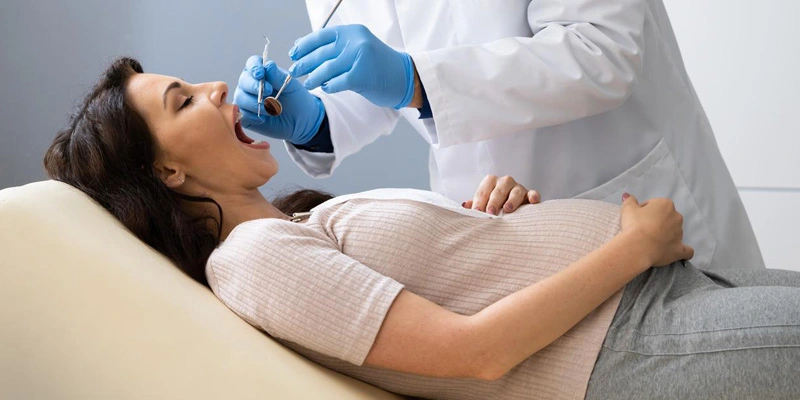Navigating healthcare decisions during pregnancy requires careful consideration, especially concerning dental health. The physiological changes experienced by expectant mothers can significantly impact oral well-being, potentially increasing susceptibility to certain conditions. Evidence-based guidelines and professional consensus emphasize the importance of maintaining optimal oral hygiene throughout gestation. Recent studies, for instance, have underscored a connection between periodontal disease and adverse pregnancy outcomes, highlighting the critical role of proactive dental care. This underscores the necessity of informed discussions with healthcare providers. Understanding the nuances of dental work while pregnant is paramount for both maternal and fetal health, ensuring interventions are safe and effective.
Table of Contents
Is Dental Work Safe During Pregnancy and When Should You Go?
Dental treatment during pregnancy remains a critical aspect of maternal healthcare that requires careful consideration and professional guidance. Most routine dental procedures are completely safe when performed during pregnancy, particularly during the second trimester.
Preventive dental care represents the safest approach throughout pregnancy. The following procedures are routinely performed without risk:
- Professional dental cleanings and examinations
- Diagnostic X-rays with appropriate abdominal shielding
- Periodontal maintenance therapy
- Emergency pain relief treatments
- Root canal therapy when medically necessary
Essential dental work should never be postponed due to pregnancy concerns. Untreated dental infections can lead to systemic complications that pose greater risks than dental intervention itself. Periodontal disease has been linked to preterm birth and low birth weight, making professional oral healthcare essential.
The timing of dental procedures varies based on treatment complexity and pregnancy stage. The table below outlines optimal timing considerations:
| Treatment Type | Timing Recommendation | Safety Level |
|---|---|---|
| Routine Cleanings | Throughout pregnancy | Completely safe |
| Emergency Care | Any trimester | Essential when needed |
| Elective Procedures | Second trimester preferred | Safe with precautions |
Local anaesthesia using lidocaine remains the standard of care during pregnancy and poses no documented risks to foetal development. Dentists routinely modify treatment protocols to accommodate pregnant patients, including positioning adjustments and shortened appointment durations.
Expectant mothers should inform their dental team about their pregnancy status and current medications. This enables practitioners to make appropriate treatment modifications while maintaining optimal oral health outcomes.
Regular dental visits every three to four months during pregnancy help prevent complications associated with pregnancy gingivitis and hormonal changes affecting oral tissues. Professional monitoring ensures early detection and management of developing dental issues before they require more extensive intervention. Safe Dental Treatment Standards ensure that necessary dental work while pregnant is performed without compromising the health of the mother and baby. Regular consultations with dental professionals contribute to maintaining optimal oral health throughout the pregnancy.
Trimester-Specific Risks: What You Need to Know About Dental Work Safety
Understanding the dangers of dental work while pregnant requires careful consideration of each trimester’s unique physiological changes and developmental milestones. Clinical experience demonstrates that timing dental procedures appropriately minimises maternal and foetal risks whilst maintaining optimal oral health throughout pregnancy.
1. First Trimester Considerations (Weeks 1-12)
The dangers of dental work while pregnant first trimester primarily stem from critical organ development occurring during this period. Organogenesis makes the foetus particularly vulnerable to external influences.
- Emergency dental treatments remain necessary despite timing concerns
- Routine cleanings and examinations pose minimal risk when performed carefully
- Complex restorative procedures should be postponed unless absolutely essential
- Local anaesthetics without vasoconstrictor additives provide safer pain management options
Radiographic imaging requires special precautions during this sensitive period, with lead aprons and thyroid collars providing essential protection when X-rays become unavoidable.
2. Second Trimester Safety Window (Weeks 13-27)
The dangers of dental work while pregnant second trimester significantly decrease, making this the optimal treatment period for most dental procedures. Maternal comfort and foetal stability reach their peak during these months.
- Comprehensive dental treatments can be performed safely
- Periodontal therapy addresses pregnancy-related gingival changes effectively
- Restorative work including fillings and crowns poses acceptable risk levels
- Oral surgery procedures may be considered when medically necessary
Professional consensus supports this trimester as the preferred timeframe for elective dental interventions, balancing treatment needs with safety considerations.
3. Third Trimester Limitations (Weeks 28-40)
The dangers of dental work while pregnant third trimester relate primarily to maternal positioning difficulties and potential preterm labour triggers. Physical discomfort and cardiovascular changes complicate dental chair positioning.
- Emergency treatments remain prioritised over elective procedures
- Appointment duration should be limited to prevent supine hypotensive syndrome
- Left lateral positioning modifications accommodate enlarged uterus pressure
- Stress reduction protocols become increasingly important
Collaborative care between dental professionals and obstetricians ensures comprehensive risk assessment throughout this final gestational period, maintaining both maternal oral health and pregnancy safety.
Medications and Anesthesia Safety for Pregnant Dental Patients
Pharmaceutical management during pregnancy requires careful consideration of teratogenic risks and maternal-foetal safety profiles. Our clinical experience demonstrates that appropriate medication selection significantly reduces complications while maintaining effective pain control and infection management.
The following table outlines evidence-based medication safety classifications for expectant mothers:
| Medication Category | Safe Options | Unsafe Options | Dosage Modifications |
|---|---|---|---|
| Local Anaesthetics | Lidocaine 2%, Articaine | Prilocaine (large doses) | Standard dosing acceptable |
| Analgesics | Paracetamol | Aspirin, Ibuprofen (3rd trimester) | Maximum 4g daily paracetamol |
| Antibiotics | Amoxicillin, Erythromycin | Tetracycline, Metronidazole | Standard therapeutic doses |
Local anaesthetic administration represents the cornerstone of comfortable dental procedures during gestation. Lidocaine with epinephrine remains the gold standard, demonstrating excellent safety profiles across all trimesters. Articaine provides comparable efficacy with minimal placental transfer, making it an excellent alternative for complex procedures.
Pain management protocols require modification to accommodate physiological changes during pregnancy. Paracetamol serves as the primary analgesic, offering effective relief without teratogenic concerns when used within recommended limits. Non-steroidal anti-inflammatory drugs present contraindications, particularly during the third trimester due to potential oligohydramnios and premature ductus arteriosus closure.
Key medication precautions include:
- Avoid prescribing codeine-based preparations due to respiratory depression risks
- Limit local anaesthetic volumes to minimum effective doses
- Consider shortened appointment duration to reduce medication exposure
- Monitor for allergic reactions more vigilantly during pregnancy
Antibiotic prophylaxis follows established protocols with pregnancy-safe alternatives. Amoxicillin remains the first-line choice for most odontogenic infections, whilst erythromycin provides effective coverage for penicillin-allergic patients. Tetracycline derivatives require absolute avoidance due to dental discolouration and skeletal development interference in the developing foetus.
Nitrous oxide administration requires careful evaluation, with current guidelines recommending avoidance during the first trimester and cautious use thereafter with proper scavenging systems.
Managing Pregnancy-Related Dental Issues: From Gingivitis to Sensitivity
Pregnancy gingivitis represents the most prevalent oral condition during gestation, affecting approximately 60-75% of pregnant women. Hormonal fluctuations, particularly elevated progesterone and oestrogen levels, increase vascular permeability in gingival tissues. This physiological change leads to enhanced inflammatory responses to bacterial plaque, resulting in swollen, tender, and bleeding gums. The condition typically emerges during the second trimester and intensifies throughout pregnancy.
Our clinical experience demonstrates that consistent oral hygiene practices significantly reduce gingivitis severity. Gentle brushing with soft-bristled toothbrushes twice daily, combined with antimicrobial mouth rinses containing chlorhexidine, provides effective plaque control. Regular dental scaling and polishing procedures remain safe throughout pregnancy and help maintain gingival health.
Dental hypersensitivity frequently accompanies pregnancy due to multiple contributing factors. Hormonal changes affect dentinal tubules, whilst dietary modifications and increased snacking frequency expose teeth to prolonged acid attacks. Additionally, pregnancy-related gastroesophageal reflux introduces stomach acids into the oral cavity, further compromising enamel integrity.
Enamel erosion presents particular challenges when morning sickness occurs. Frequent vomiting episodes create an acidic oral environment with pH levels dropping below 5.5, the critical threshold for enamel demineralisation. The combination of acidic gastric contents and subsequent tooth brushing can accelerate enamel loss, leading to increased sensitivity and aesthetic concerns.
Management strategies focus on acid neutralisation and remineralisation protocols. We recommend rinsing with water or sodium bicarbonate solutions immediately after vomiting episodes, followed by waiting 60 minutes before brushing to allow enamel rehardening. High-fluoride toothpastes containing 5000ppm fluoride provide enhanced remineralisation benefits for compromised enamel surfaces.
Calcium and phosphate supplementation through professional topical applications supports enamel repair mechanisms. Casein phosphopeptide-amorphous calcium phosphate complexes demonstrate superior remineralisation properties compared to conventional fluoride treatments alone. These interventions, combined with dietary counselling regarding acidic food limitation, effectively manage pregnancy-related dental sensitivity whilst protecting long-term oral health outcomes.
Essential Guide to Maintaining Oral Health During Pregnancy
Pregnancy brings significant changes to oral health, making dental health pregnancy protocols essential for both maternal and foetal wellbeing. Hormonal fluctuations increase susceptibility to periodontal disease and dental complications throughout gestation.
Daily oral care practices during pregnancy:
- Brush twice daily with fluoride toothpaste using soft-bristled toothbrush
- Use antimicrobial mouthwash to reduce bacterial load
- Floss daily to prevent plaque accumulation between teeth
- Maintain calcium-rich diet supporting tooth enamel strength
- Avoid sugary snacks that promote bacterial growth
The NHS provides comprehensive pregnancy dental care coverage, ensuring expectant mothers receive necessary treatments without financial barriers.
| NHS Dental Service | Coverage | Availability |
|---|---|---|
| Routine examinations | Free | Throughout pregnancy |
| Emergency treatments | Free | 24/7 access |
| Preventive care | Free | Includes scaling, polishing |
| Restorative work | Free | Fillings, crowns when necessary |
Essential timeframes for seeking dental care:
- First trimester: Schedule comprehensive examination and professional cleaning
- Second trimester: Address any identified issues through appropriate treatments
- Third trimester: Focus on maintenance and emergency care only
- Postpartum: Complete any deferred procedures within twelve months
Our extensive clinical experience demonstrates that maintaining rigorous oral hygiene prevents pregnancy gingivitis, which affects approximately 60-75% of pregnant women. Regular professional monitoring identifies potential complications before they escalate into serious conditions.
Dental work while pregnant requires careful consideration of treatment timing and techniques. Preventive care remains the cornerstone of prenatal oral health management, significantly reducing risks of premature labour associated with severe periodontal disease. Establishing consistent oral care routines during pregnancy creates lasting habits that benefit long-term maternal dental health.



